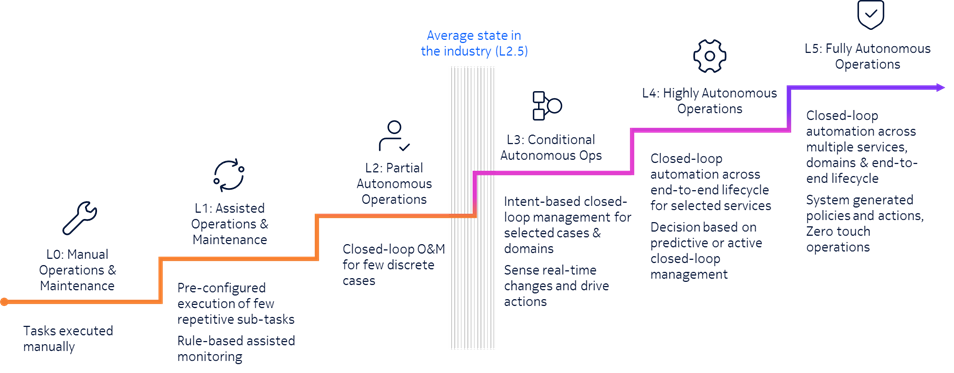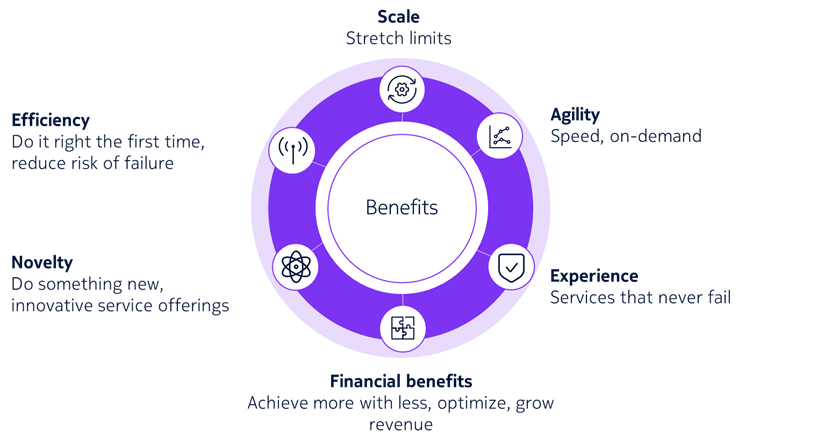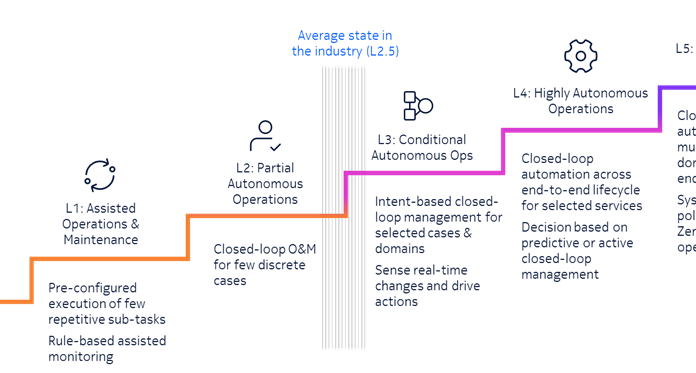The telecom industry continues to undergo a revolution fueled by 5G, the evolution of cloud-native technologies and open ecosystems, and the increasing demand for “always-on” networks with guaranteed service level agreements (SLAs) for personalized experiences.
Managing this complexity requires communication service providers (CSPs) to look to automation and AI to run networks with less human intervention. Traditional, human-led network operational models are not able to manage these dynamic operating environments, and so CSPs today are on a journey to achieve truly autonomous networks.
The evolution from automation to autonomous networks
Automation as a concept is not new, and the evolution towards autonomous networks can be seen as taking automation and AI to the next level.
On this journey, a few enablers will play a key role, including intent management which helps to capture business needs easily, digital twin-led simulations paving the way to reduce risk of operations, and GenAI, which enables users to quickly generate new content based on a variety of inputs.
This evolution away from traditional automation can be characterized in several ways including:
- Focus: When automation is used in network operations, the what and the how must still be specified. In the case of autonomous networks, only the goal needs to be specified using intents, and the ‘how’ is derived from this, bringing a new level of simplicity to the process.
- Conditions: With traditional automation, the conditions under which we automate are well specified and defined per configuration. With autonomous networks, the automation rules are not pre-engineered but dynamically derived in real time, which is needed in the new world where network conditions change rapidly, and services need to adapt accordingly to maintain the experience.
- Ease of operations: In automated networks, operations are domain-specific and technology-oriented, compared to cross-domain, abstract and goal-based, with lesser requirements for network know-how in autonomous networks.
- Human intervention: With automation, decisions are human-led or require a human in the loop, but with autonomous networks, they are system-led with humans outside the loop for oversight and control if necessary.
- Benefits: Traditional automation focuses on immediate and specific goals, making operations faster or easier. Autonomous networks enable a wider exposure, bringing business benefits with a wider span of focus that is cross-domain and flow-focussed rather than task specific. This unlocks the exponential power of networks and enables network monetization with differentiated experiences for end users.
This fundamental shift from automation to autonomous networks can create more efficient and error-free network operations and make zero-touch operations a reality.
Autonomous networks open the door to significant benefits
TM Forum has been driving the industry and setting the standard around defining and achieving autonomous networks, and what is required at each level of autonomy. These levels range from Level 0: manual operations and maintenance all the way to Level 5: fully autonomous operations.

Although CSPs have a ladder to climb in their journey towards autonomous networks, the benefits are significant and far-reaching for those who succeed. At a high level, the benefits can be grouped into the following six categories: experience, efficiency, financial benefits, scale, agility and novelty.

Three areas from the above list are particularly important to consider, the first of which is improved customer experience. Autonomous networks allow CSPs to offer true service differentiation and the ability to deliver a unique customer experience, for example, through guaranteed performance and error-free networks.
Likewise with network efficiency, CSPs add intelligent decision-making systems to perform the same process that would have been done manually, allowing for processes to continuously evolve to deliver the most efficient and accurate outcomes.
Finally, these shift towards autonomous networks can unlock significant savings on operating expenses (opex) and capital expenditures (capex). Various industry projections have said this could value $600 million to $1 billion over multiple years as well as provide new monetization opportunities through better allocation of human capital towards service innovation and cost reduction through optimal usage of resources.
Focus areas to consider
The benefits of achieving autonomous networks are significant, but cost savings and revenue increases will only be unlocked when CSPs reach TM Forum’s Levels 4 and 5 of autonomous networks.
To achieve this, CSPs need to have a focused plan and define which areas to focus on when. CSPs should zero-in their short-term investments on automating high-impact domains such as resource management, service assurance, and network planning.
With resource management, CSPs can move towards dynamic and intelligent management of resources and power across domains based on patterns in usage and demand, automating load distribution across the cloud. Of note, this requires provisioning the network beyond the radio access network (RAN).
Likewise, by focusing on service assurance, CSPs can uncover hidden issues across domains and pre-empt problems using AI/machine learning (ML) that would have not otherwise been anticipated, helping to ensure networks never fail/
Finally, network planning allows CSPs to move from leveraging simple visualization tools for understanding the network and analyzing traffic for capacity management to more advanced and intelligent orchestrations across multiple domains that can self-optimize.
The journey toward autonomous networks is not a simple or straight path but that doesn’t mean it’s not achievable. A clear iterative approach is all that is needed: setting the goal, defining the path to get there, executing and measuring the progress, followed by refining the process. Then, pick up the next problem area to tackle and goal to address, and repeat.
Autonomous networks are the key to unlocking a new era of efficiency, innovation and growth for CSPs, and those who fail to adapt will be left behind.

